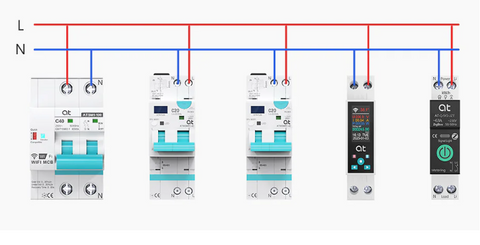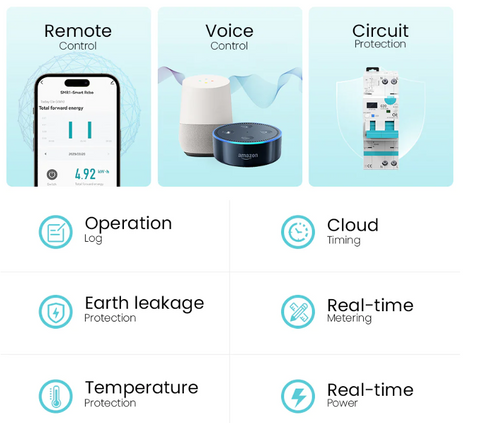Why Is Smart breaker Not Working and What Can I Do About It?

Smart circuit breakers have revolutionized the way we manage and monitor our electrical systems, offering increased convenience and safety. However, encountering issues with a non-functioning smart breaker can be frustrating. In this guide, we will explore the potential reasons behind a malfunctioning smart breaker and provide step-by-step solutions to address these problems.
Reasons for Smart Circuit Breaker Not Working

Troubleshooting a Non-Functioning Smart Circuit Breaker
A smart circuit breaker improves electrical system management and safety, but issues with its functionality can be annoying. If your smart breaker is not working as expected, there are several potential reasons to consider. In this guide, we'll delve into each issue and provide step-by-step solutions to help you restore its proper operation.
A. Power Supply Issues
1. Check for Power Source and Connections
The first step in troubleshooting a non-functioning smart circuit breaker is to inspect its power source and connections. Make sure you securely connect all wires and cables to the appropriate terminals. Loose or disconnected wires can lead to erratic behavior or a complete loss of function. Verify that the breaker is receiving power from the electrical panel.
2. Verify Proper Voltage and Current Levels
Smart circuit breakers are electrical devices that operate within specific voltage and current ranges. Using a voltage tester, confirm that the voltage and current levels are within the manufacturer's recommended specifications. Deviations from these ranges can impact the device's performance or cause it to malfunction.
B. Network Connectivity Problems
1. Ensure Stable Wi-Fi or Network Connection
Smart circuit breakers rely on a stable network connection to function properly. Make sure that the device is within range of a reliable Wi-Fi signal. A weak or intermittent signal can result in communication issues between the breaker and your mobile app or home automation system.
2. Troubleshoot Network Settings and Router Issues
If you're experiencing network connectivity problems, consider troubleshooting your router and network settings. Restart your router, as this can often resolve temporary connectivity glitches. If the issue persists, check for any potential interference sources that might be affecting your Wi-Fi signal.
C. Firmware or Software Glitches
1. Update Smart Circuit Breaker's Firmware
Manufacturers release firmware updates to address bugs, improve performance, and introduce new features. Ensure that your smart circuit breaker's firmware is up to date by checking the manufacturer's website or using their dedicated app. Updating the firmware might resolve compatibility issues or software glitches that could be causing the problem.
2. Restart or Reset the Device
If your smart circuit breaker is unresponsive or behaving unpredictably, try restarting or resetting the device. Refer to the manufacturer's instructions for the proper procedure. This action can often clear temporary software glitches and restore the breaker's functionality.
D. Hardware Malfunctions
1. Inspect for Physical Damage or Defects
Examine the smart breaker for any signs of physical damage, such as burned components, visible defects, or loose connections. Physical damage can significantly impact the device's performance or render it completely non-functional. Identifying and addressing such issues promptly is crucial.
2. Consider Professional Inspection or Replacement
If you suspect a hardware malfunction that you are unable to resolve on your own, it's advisable to seek professional assistance. Contact the manufacturer's support or a professional electrician to inspect the device and diagnose the problem. Depending on the severity of the issue, they can guide you on potential repairs or recommend a replacement if necessary.
A broken smart circuit breaker can happen because of power problems, network issues, software bugs, or hardware failures. To fix your smart breaker, address each issue and follow the suggested solutions systematically. This will restore its proper functionality. Remember that safety is paramount, and if you're unsure or encounter complex problems, seeking professional help is always a wise decision.
Troubleshooting and Solutions for Non-Functioning Smart Circuit Breakers

When a smart breaker fails to operate as expected, troubleshooting is key to identifying and rectifying the issue. This section provides practical solutions for each potential problem area, helping you restore your smart breaker's functionality.
A. Power Supply Solutions
1. Verify Power Source and Connections
Begin by ensuring that all power source connections are secure and properly seated. Double-check that you tightly connect wires and cables to their respective terminals. A loose connection can disrupt the power supply and result in malfunctions.
2. Use a Voltage Tester to Check Electrical Supply
To confirm the integrity of the electrical supply, use a voltage tester. Test the voltage levels at the breaker's input terminals and compare the readings with the manufacturer's recommended specifications. If the voltage is significantly outside the acceptable range, address the power supply issue accordingly.
B. Network Connectivity Solutions
1. Improve Wi-Fi Signal Strength
If network connectivity is the culprit, enhancing your Wi-Fi signal strength can help. Position the smart breaker within range of a strong and stable Wi-Fi signal. Consider using Wi-Fi range extenders or mesh systems to ensure consistent connectivity throughout your home.
2. Reset Network Settings on the Smart Circuit Breaker
If the breaker is struggling to maintain a network connection, perform a network settings reset as per the manufacturer's instructions. This action can often resolve temporary network-related issues and establish a reliable connection.
C. Firmware or Software Solutions
1. Update Firmware Through the Manufacturer's App
Regularly check for firmware updates provided by the manufacturer. Use their dedicated app or visit their website to download and install the latest firmware version. Updated firmware can address software glitches, improve performance, and enhance compatibility.
2. Perform a Reset as per Manufacturer's Instructions
If the smart circuit breaker exhibits erratic behavior or becomes unresponsive, follow the manufacturer's guidelines to perform a reset. This action can clear software glitches and restore the device to its default settings, potentially resolving the issue.
D. Hardware Solutions
1. Contact Manufacturer's Support for Assistance
When faced with hardware-related problems, don't hesitate to reach out to the manufacturer's customer support. They can provide expert guidance on troubleshooting steps, identify potential hardware issues, and offer solutions to address them.
2. Consider Replacing the Smart Circuit Breaker if Necessary
In some cases, hardware malfunctions may be irreparable or cost-prohibitive to fix. Consider purchasing a new smart circuit breaker if the manufacturer recommends replacing it. This will help ensure the safety and proper functioning of your electrical system.
Remember, safety should always be a priority. If you encounter difficulties during troubleshooting or feel uncomfortable with any aspect of the process, it's advisable to seek professional assistance. Licensed electricians or technicians can expertly inspect, repair, or replace your smart breaker to ensure proper functionality.
To fix your smart breaker, follow these steps to solve power, network, firmware, and hardware problems that may be causing issues. Restoring its proper operation will contribute to the overall efficiency and reliability of your home's electrical system.

Maintaining the functionality and performance of your smart circuit breaker is essential for the safety and efficiency of your electrical system. By taking preventive steps, you can reduce the chance of problems and make sure your smart breaker works well. Here's how you can take steps to prevent potential problems:
A. Regular Maintenance
1. Check for Updates and Install Them Promptly
Manufacturers often release firmware updates to address bugs, improve security, and enhance features. Regularly check for updates for your smart circuit breaker through the manufacturer's app or website. When updates are available, install them promptly to ensure your device remains up to date and optimized.
2. Inspect the Device for Physical Damage Periodically
Perform routine visual inspections of your smart breaker to check for any signs of physical damage or wear. Look for burnt components, loose connections, or other visible defects. Addressing minor issues early can prevent them from escalating into major problems that could compromise the device's functionality.
B. Power and Network Monitoring
1. Monitor Voltage and Current Levels
Keep a vigilant eye on the voltage and current levels of your electrical system. Fluctuations or deviations from the recommended ranges can impact the performance of your smart circuit breaker. Consider using a voltage tester periodically to ensure that the electrical supply remains within acceptable limits.
2. Keep an Eye on Wi-Fi Signal Strength and Network Stability
Keep a strong network connection by checking the Wi-Fi signal and stability in the smart breaker's location. A good network connection is important for smooth communication between the breaker and your app or home system.
By incorporating these preventive measures into your routine, you can significantly enhance the reliability and longevity of your smart circuit breaker. Regular maintenance, combined with vigilant monitoring of power supply and network conditions, will help you identify and address potential issues before they impact the functionality of your device. By following these steps, you can have a secure and effective electrical system. It will also give you peace of mind, as your smart breaker will be functioning optimally.
Conclusion
A functional smart circuit breaker is essential for maintaining the safety and efficiency of your electrical system. When faced with a non-functioning device, it's important to troubleshoot systematically, addressing power supply, network, software, and hardware issues. By following the steps outlined in this guide, you can diagnose and resolve the problem, ensuring that your smart breaker operates smoothly and efficiently for years to come.
Contact:
AT-ELE
sale@at-ele.com
www.at-ele.com



